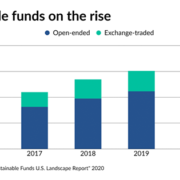[ InvestmentNews ] SRI or Die: Time to Get on Board the Responsible Investing Trend
“If you’re not talking with your clients about sustainable, responsible, and impact investing, they’ll be speaking with someone else.” That’s a line I used last week while speaking to a group of financial advisers at a conference in Michigan. And it’s true.
Those of us who are practitioners in the SRI/ESG space have known for a long time that responsible investing has continued to gain momentum year over year. The trend is not slowing down – if anything, it’s sped up consistently since 2012. But 2020 seemed to be the tipping point where the niche became mainstream. In its 2020 biennial report on US Sustainable and Impact Investing Trends, US SIF reported that sustainable assets had reached over $17.1 trillion — a 25-fold increase since they started tracking assets in 1995.
According to Morningstar, there are currently 439 different SRI/ESG mutual funds and ETFs available to investors in the U.S. Ten years ago, there were just 99. That’s nearly a 450% increase, and much of this growth is being driven by consumer demand. Even so, consumers and advisers aren’t always seeing eye to eye when it comes to investing responsibly.
The Adviser/Client Disconnect
A recent survey by Natixis asked whether respondents agreed with the following questions: “I want to make a positive social impact with my investments” and “I want my investments to match my personal values.” Seventy-one percent of respondents agreed with the first statement and 81% agreed with the second. Interestingly, these respondents weren’t just millennials — as is the common assumption — but also included Gen X, boomers, and even the Silent Generation. These are the highest positive responses to SRI/ESG that we’ve seen to date.
Yet there’s a serious disconnect among investment advisers and their perception of SRI. According to a 2020 survey from Cerulli Associates, more than half of investment advisers believe a lack of client demand is a significant factor preventing their adoption of ESG strategies. “Based on our research, advisers generally underestimate the demand their clients have for ESG and should not interpret lack of proactive questions as a lack of client interest,” said Matt Belnap, a senior analyst at Cerulli. What this says is that advisers aren’t talking to their clients about SRI investing. If they are, they aren’t taking it seriously — which will ultimately be to their own detriment.
Moving Forward
So if you haven’t already done so already, now’s the time to start learning more about SRI investing and how best to implement your strategy. Do you use a basic ESG ETF or a more stringent SRI fund? It’s important to conduct some due diligence, as not all of the 439 funds listed by Morningstar are equal. Many, including some of the largest, have holdings in companies such as ExxonMobil, Raytheon, McDonald’s, and DuPont. If you look under the hood and the investments don’t pass the “does it make sense for a sustainable, responsible and impact fund to hold ______?,” then move on to a different fund. You don’t want clients asking you why their fund holds fossil fuels, defense stocks or chemicals when there are legitimate alternatives that align with their values. For a more customized approach, consider separately managed account options.
Like it or not, the business is moving toward a more intentional investment model and it’s being driven by our clients who care about what they own. As we approach the impending Great Wealth Transfer that will see trillions of dollars change hands from boomers to millennials, you can either stick your head in the sand or you can be proactive about it and be the leader and adviser they’re paying you to be. The sooner you start the conversation with your clients about what they care about, the better.
Originally published in InvestmentNews
Featured Image: Flash Dantz on Unsplash


 ZUMA PRESS
ZUMA PRESS Getty
Getty



